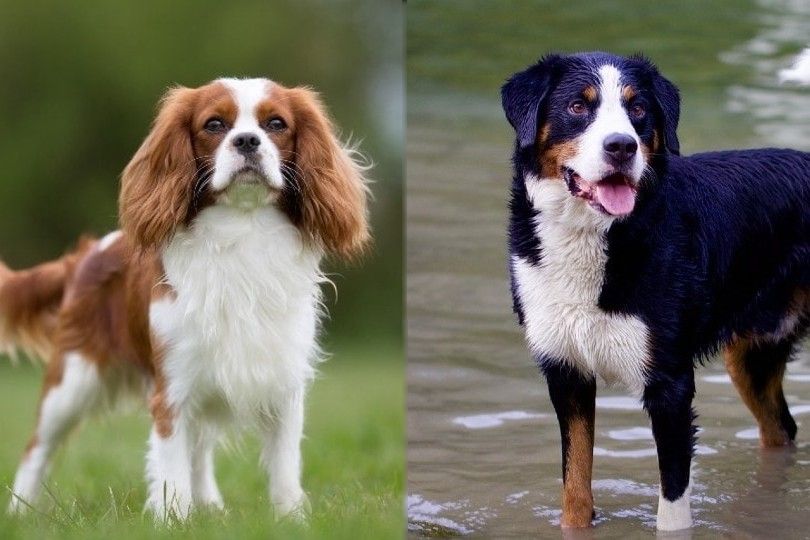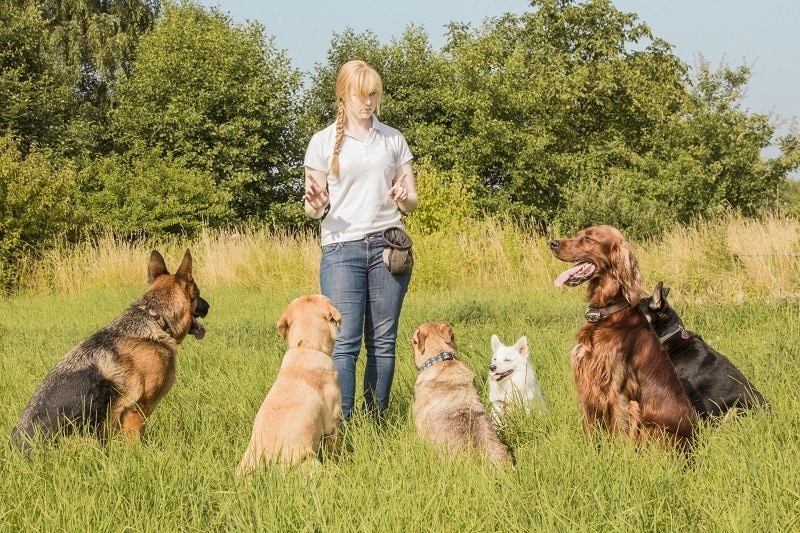Czech German Shepherd: Info, Pictures, Characteristics & Facts

Updated on
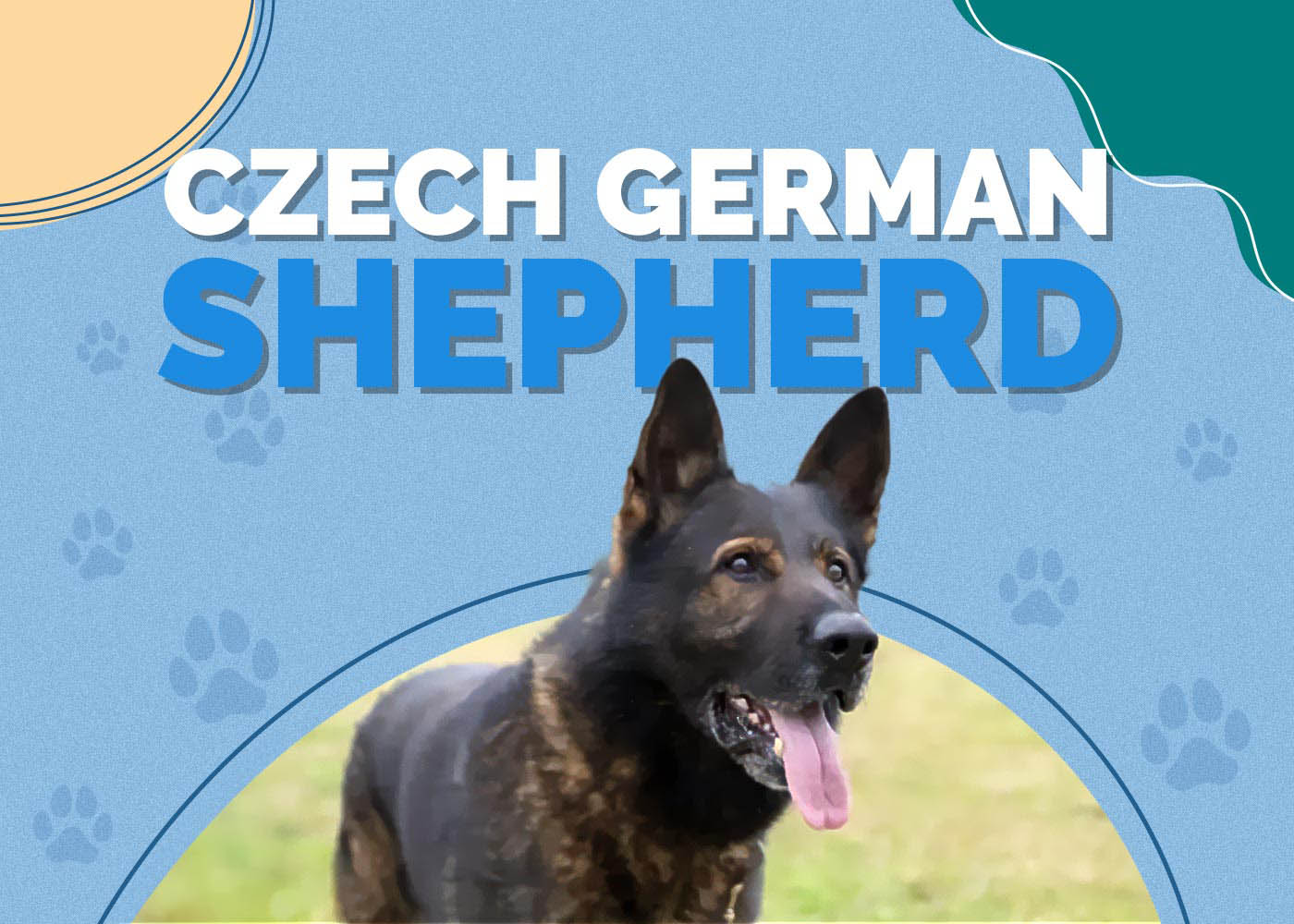
| Height: | 24–26 inches |
| Weight: | 66–88 pounds |
| Lifespan: | 12–15 years |
| Colors: | Sable, black |
| Suitable for: | Active families, those looking for an easily trainable dog |
| Temperament: | Smart, loyal, energetic, obedient, athletic, affectionate |
You may not realize it, but there are actually several different kinds of German Shepherd out there, including American, East German, West German, and Czech. The differences between the various bloodlines may be subtle, but they’re definitely there.
It’s important to realize that Czech German Shepherds are only a different bloodline, not a completely different breed. They still have all the usual characteristics of a regular German Shepherd, just with little differences here and there.
Whether you’re a German Shepherd enthusiast or just someone who enjoys learning about the variations between bloodlines, this guide can fill you in on everything you need to know about these wonderful dogs.
Czech German Shepherd Puppies
https://www.instagram.com/p/CXb6jKDv7UP/
Relative to most other German Shepherd bloodlines, Czech German Shepherds mature more slowly. If you want a dog that will stay puppy-like for a good amount of time, these dogs make a great fit. Be aware that they’ll only stay puppy-like in terms of their demeanor, however. These dogs have a denser bone structure than other German Shepherd lines, so they’ll usually be a bit beefier than their counterparts.
They’ll pack on muscle over all that dense bone as they get older, so these pups will look even more athletic than regular German Shepherds. This, combined with their puppy-like nature, will make them quite the handful for the first few years of their lives.
They also have extremely powerful jaws, and while they aren’t prone to aggression, you may have to deal with a great deal of nipping and mouthing in the first few months of their life. This can be quite painful, but try to ignore it or redirect them to a suitable chew toy and rest assured that they’ll grow out of it before long.
The 3 Little-Known Facts About the Czech German Shepherd
1. They were originally bred to be border guards.
The Czech line German Shepherd dates back to when the Czech Republic was part of the U.S.S.R., and the dogs were originally used by border guards starting in the 1950s. They made an excellent choice, as these dogs are powerful, tenacious, and capable of running anyone down—and keeping them down once caught.
Over the years, they began to be bred as pets rather than working dogs. This has caused them to be much friendlier, but they still have that ferocious streak buried deep inside, so it’s important to train and socialize them as much as possible.
2. Being bred to work with humans has left them craving companionship.
Even when they were being used to hunt down potential border crossers, these dogs were known for forging close bonds with their human handlers. They naturally seek to grow closer to the humans in their lives.
That means, despite looking fierce and powerful, they’re extremely codependent. If they had it their way, they’d be around their humans 24/7. We understand that it’s not feasible to hang out with your dog at all hours of the day, so it’s best that you only adopt a Czech German Shepherd if you can give them plenty of time and attention during the week.
3. Their loyalty can sometimes reach the point of obsessiveness.
These dogs sometimes get so attached to their owners that they refuse to leave their sides. Separation anxiety is a big problem with the breed, so you’ll need to work to build up their confidence before you start leaving them alone for long periods.
Also, you need to be sure that the dog doesn’t become overly attached to a single person in the family. They can be protective of that person, even toward other members of the family. To avoid potential issues, nip possessiveness in the bud.
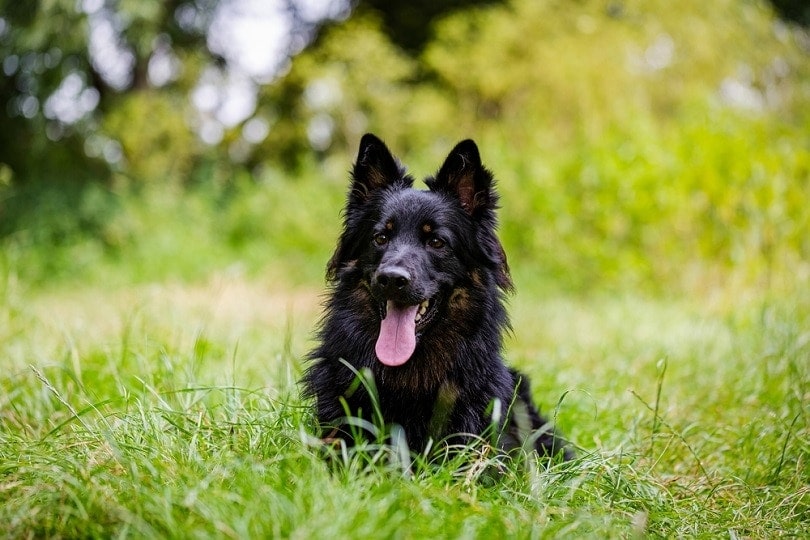
Temperament & Intelligence of the Czech German Shepherd 🧠
Czech German Shepherds are some of the sweetest and most affectionate animals on the planet. They love to be around people, and they’re likely to spend most of their time trying to figure out how to sneak into your lap. They can also be quite tenacious. They were bred to be single-minded, so once they get it in their head to do something (like crawl into your lap), they may become fixated on it. During training, you’ll need to work on pulling their focus to you.
However, they’re fiercely intelligent. German Shepherds in general are considered the third-smartest dog breed, and many people consider the Czech bloodline German Shepherds to be the smartest overall. That’s likely due to their rigorous training background as part of the Soviet empire.
This intelligence makes them easy to train, but it can also make them mischievous by nature. They can be inquisitive and may decide to look around your kitchen for snacks while you’re away. However, they’re even more obedient, so it’s easy to instill good manners into them. You’ll be hard-pressed to find a dog that combines keen intelligence with unending warmth, but the Czech German Shepherd manages to do both with ease.
Are These Dogs Good for Families? 🏡
Very few dogs make better family pets than a Czech German Shepherd. They’re extremely loyal and affectionate, and they can be incredibly patient with kids. This is one pooch that will make you the center of their entire world. In addition to offering friendship, they’ll also be devoted to protecting your entire family. They can make terrifying guard dogs, and their very presence in your home may be enough to convince criminals to look elsewhere.
However, that doesn’t mean that there aren’t any potential issues to be aware of. You should never leave any dog alone with your children, no matter how loving and trustworthy they may seem.
Czechoslovakian German Shepherds can be possessive of certain people, and that could potentially lead to aggression issues, so try to prevent it from happening if you can. Also, like any dog, they can be aggressive if not properly trained and socialized, so prioritize both those things from day one. German Shepherds are energetic dogs in general, and the Czech bloodline is no exception, so you’ll likely need to enlist your entire family in the process of exercising them.

Does This Breed Get Along With Other Pets? 🐶 😽
This answer will depend on how thoroughly the dog is socialized as a puppy. These dogs can be quite accepting of other pets, but they can also be dominant toward them as well. As a result, you should take things slow when introducing them to new pets. Ideally, the introduction will happen while the Czech German Shepherd is still a puppy, so they’ll grow up with the other animal, rather than having a new pet thrust upon them unexpectedly.
If properly socialized, there’s a good chance that your Czech German Shepherd will happily welcome another dog as a playmate. This can also help you by reducing their exercise needs, giving you a little bit of a respite.
However, they’ll never love another dog as much as they do their humans, so don’t worry about feeling like you’re being replaced. In fact, there may be potential jealousy issues to work through with another dog.
As far as cats and other small pets are concerned, many Czech German Shepherds can come to view them as fellow family members, provided that there is plenty of socialization beforehand. Don’t introduce a new pet into the household unless you’re extremely confident in how your dog will react, though, because these pups are both athletic and tenacious, which is a bad combination for any animal that they view as prey.
Things to Know When Owning a Czech German Shepherd
By and large, owning a Czech German Shepherd isn’t much different from owning a regular one, so you shouldn’t be in for many surprises. Even so, there are a few things that you should be aware of before you bring one of these sweet pups home.
Food & Diet Requirements 🦴
Despite being more muscular than most other German Shepherd bloodlines, these dogs eat the same amount, so don’t make the mistake of overfeeding them. Follow the manufacturer’s instructions for any kibble you choose, but a few cups per day should be plenty. As far as the kibble itself, make sure it’s a high-protein formula with plenty of fat and fiber inside. This will ensure that your dog gets all the energy they need while still staying full between meals and keeping regular.
Avoid problematic ingredients like corn, wheat, soy, or animal by-products. These offer little more than empty calories, and you want to keep your German Shepherd lean and trim, as carrying excess weight is terrible for their spine. Overfeeding them should be avoided at all costs. Don’t let them free-feed, but instead, give them two or three portion-controlled meals per day. Be careful about how many treats you give them, and limit the table scraps.
As a breed, German Shepherds are prone to developing food allergies, so if you notice inflammation, skin issues, or other questionable symptoms, you may want to start investigating their diet. They may do best on a limited-ingredient formula in order to reduce the number of potential culprits.
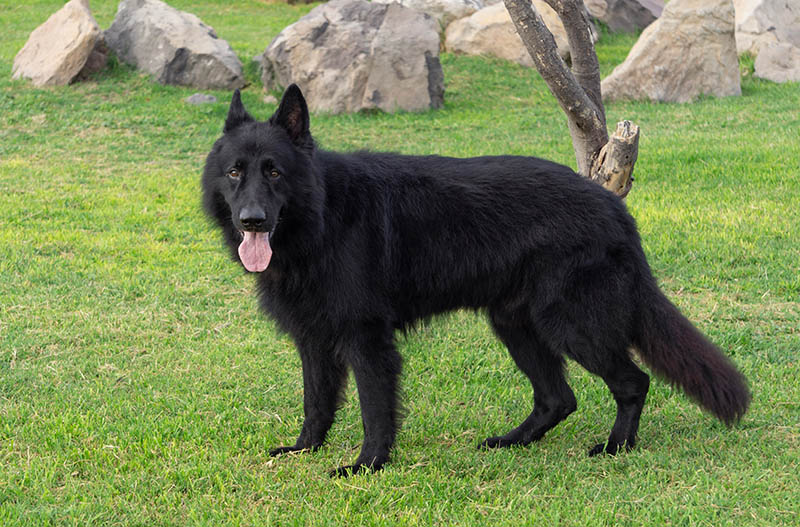
Exercise 🐕
All German Shepherds need a ton of exercise, and the Czech bloodline is no exception. This dog isn’t suitable for sedentary families, as they will pretty much demand that you get up and play with them multiple times per day. Still, they can be suitable for apartment life, as they’re relatively docile if they get enough exercise. They can be perfectly happy curling up next to you on the couch if they’ve done enough running around earlier in the day.
While walks are always a good idea, they’re likely to be insufficient for tuckering these pooches out. You’ll need a big backyard or access to a park so they can stretch their legs out and run around a little bit.
You can also tucker them out mentally by putting them through obedience training. They love to learn, so they’ll take to the training as eagerly as they would a game of fetch. You may also consider signing them up for agility training or similar canine competitions. Just be careful about forcing them to do anything too strenuous. Like all German Shepherds, their low-slung backs put them at risk of joint and spinal issues, so avoid anything that involves tons of running, jumping, or stair climbing.
Training 🦮
There aren’t many breeds that are as eager to learn as Czechoslovakian German Shepherds, so you should find training to be a breeze. The fact is that you can teach these dogs to do just about anything that you want them to. However, you may need to change up the training regimen often. While their keen intelligence can help them pick up on new commands quickly, it can also make them more likely to get bored with the same old routine.
Be careful not to punish them or use other punitive measures when training, as that can lead to aggression issues or other problems. Instead, use positive reinforcement; treats and praise will go much further than choke chains or shock collars. You need to train them as soon as you bring them home as puppies, and the training should be a daily occurrence for as long as you own the dog. Fortunately, their people-pleasing nature ensures that this should never be much of a hassle.
Socialization is just as important as training, and you should try to introduce your dog to as many new people and situations as possible. This builds up their confidence and reduces the risk of aggression issues, making them much more pleasant to be around for all involved.

Grooming ✂️
Unlike other German Shepherd bloodlines, Czech German Shepherds are heavily prone to seasonal shedding. It may well seem like their entire coat falls off at the beginning of both winter and summer, so be prepared for that. Even when they’re not blowing their coats, they’ll shed frequently, so you’ll want to brush them every day if you don’t want your entire house to become coated in dog hair.
They don’t need frequent bathing, though, and bathing them too much can strip their skin of its natural oils. Limiting baths to times when the dog is visibly dirty is fine. Beyond that, they’ll need their teeth brushed daily, their nails trimmed as necessary, and their ears cleaned at least once a week with a damp towel.
If you start all of these regimens while they’re still puppies, you’ll find that they’ll tolerate them much better once they’re full-grown. That’s good news for you, as wrestling with an adult German Shepherd often doesn’t end well for anyone involved.
- See Also: 11 Best Dry Dog Shampoos
Health and Conditions ❤️
Czech German Shepherds are relatively healthy dogs, but they are prone to a few congenital conditions that can be both painful for them and expensive for you. However, it’s important to realize that many of these conditions can be mitigated or even avoided by feeding your dog a healthy diet and providing them with plenty of exercise. Obesity is terrible for these pups, all the more so because it tends to complicate other existing health issues.
The biggest issue that you’ll likely encounter with these dogs involves their low-slung backs. This is a distinctive German Shepherd trait, but it can lead to all manner of joint and spine issues later in life.
- Cataracts
- Corneal dystrophy
- Skin allergies
- Food allergies
- Hip dysplasia
- Osteochondrosis
- Bloat
- Cardiomyopathy
- Aortic stenosis
Male vs. Female
Males tend to be physically larger than females, but the difference is often slight—only a few pounds in weight and an inch or two in height.
As far as personality goes, females tend to be more affectionate and clingier. They love nothing more than to soak up all the love and pettings that you can provide. Males, on the other hand, are more interested in patrolling the perimeter and keeping their families safe than getting love, but they won’t turn down a few head scratches either.
Males also tend to be more territorial, which could be an issue with strangers (both animal and human). However, nothing is more ferocious than a female German Shepherd protecting her family, so you should be safe from harm with either one around—provided that you teach them how to utilize that aggression, of course. If you’re planning on having a multi-dog household, it’s best if you pair either sex with an animal of the opposite sex. Males tend to be competitive with other males, and many females won’t tolerate the presence of another female in their house.
Of course, all these traits can be mitigated by having your dog fixed, but it’s unlikely that you’ll ever fully eliminate them.
Conclusion
Many people don’t realize that there are different bloodlines within the German Shepherd breed, much less that these bloodlines can play an important role in the dog’s personality. The Czech bloodline is one of the best in terms of making fantastic pets, as Czech German Shepherds tend to be loyal, affectionate, and eager to please.
Czechoslovakian German Shepherds have all the same issues that other bloodlines do, though, including aggression problems if not properly trained and socialized. They’re also extremely rambunctious, so they’re not a good fit for anyone who doesn’t enjoy spending hours playing with their dog.
You can’t really go wrong with adopting a German Shepherd, regardless of bloodline—that’s why they’re perennially one of the most popular dog breeds in the world. If you get the chance, though, take a Czech German Shepherd for a test drive. You’ll likely fall in love with their sweet personalities — and they’ll likely never let you out of their sight again.
Featured Image Credit: Jess Whitney, Shutterstock





